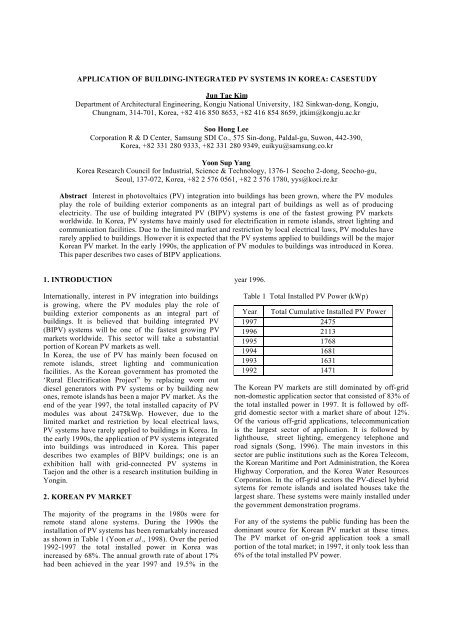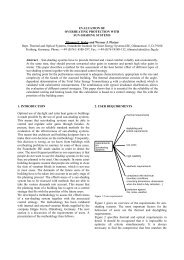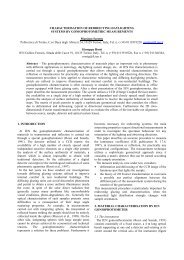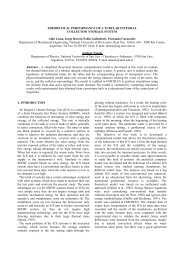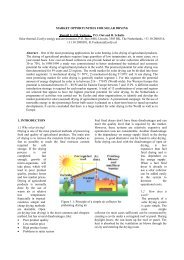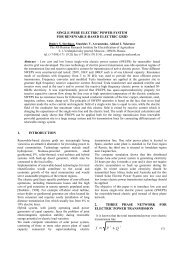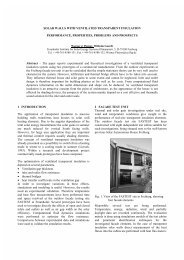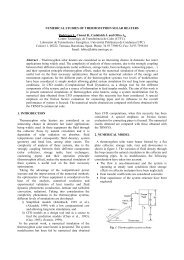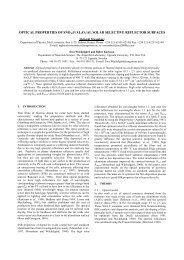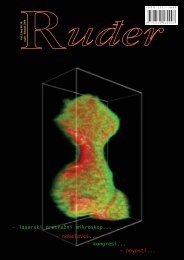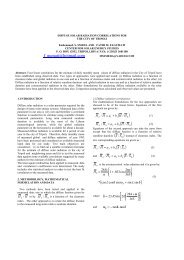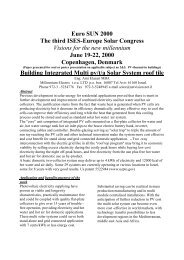APPLICATION OF BUILDING-INTEGRATED PV SYSTEMS IN ...
APPLICATION OF BUILDING-INTEGRATED PV SYSTEMS IN ...
APPLICATION OF BUILDING-INTEGRATED PV SYSTEMS IN ...
You also want an ePaper? Increase the reach of your titles
YUMPU automatically turns print PDFs into web optimized ePapers that Google loves.
<strong>APPLICATION</strong> <strong>OF</strong> <strong>BUILD<strong>IN</strong>G</strong>-<strong><strong>IN</strong>TEGRATED</strong> <strong>PV</strong> <strong>SYSTEMS</strong> <strong>IN</strong> KOREA: CASE STUDYJun Tae KimDepartment of Architectural Engineering, Kongju National University, 182 Sinkwan-dong, Kongju,Chungnam, 314-701, Korea, +82 416 850 8653, +82 416 854 8659, jtkim@kongju.ac.krSoo Hong LeeCorporation R & D Center, Samsung SDI Co., 575 Sin-dong, Paldal-gu, Suwon, 442-390,Korea, +82 331 280 9333, +82 331 280 9349, euikyu@samsung.co.krYoon Sup YangKorea Research Council for Industrial, Science & Technology, 1376-1 Seocho 2-dong, Seocho-gu,Seoul, 137-072, Korea, +82 2 576 0561, +82 2 576 1780, yys@koci.re.krAbstract Interest in photovoltaics (<strong>PV</strong>) integration into buildings has been grown, where the <strong>PV</strong> modulesplay the role of building exterior components as an integral part of buildings as well as of producingelectricity. The use of building integrated <strong>PV</strong> (BI<strong>PV</strong>) systems is one of the fastest growing <strong>PV</strong> marketsworldwide. In Korea, <strong>PV</strong> systems have mainly used for electrification in remote islands, street lighting andcommunication facilities. Due to the limited market and restriction by local electrical laws, <strong>PV</strong> modules haverarely applied to buildings. However it is expected that the <strong>PV</strong> systems applied to buildings will be the majorKorean <strong>PV</strong> market. In the early 1990s, the application of <strong>PV</strong> modules to buildings was introduced in Korea.This paper describes two cases of BI<strong>PV</strong> applications.1. <strong>IN</strong>TRODUCTIONInternationally, interest in <strong>PV</strong> integration into buildingsis growing, where the <strong>PV</strong> modules play the role ofbuilding exterior components as an integral part ofbuildings. It is believed that building integrated <strong>PV</strong>(BI<strong>PV</strong>) systems will be one of the fastest growing <strong>PV</strong>markets worldwide. This sector will take a substantialportion of Korean <strong>PV</strong> markets as well.In Korea, the use of <strong>PV</strong> has mainly been focused onremote islands, street lighting and communicationfacilities. As the Korean government has promoted the‘Rural Electrification Project” by replacing worn outdiesel generators with <strong>PV</strong> systems or by building newones, remote islands has been a major <strong>PV</strong> market. As theend of the year 1997, the total installed capacity of <strong>PV</strong>modules was about 2475kWp. However, due to thelimited market and restriction by local electrical laws,<strong>PV</strong> systems have rarely applied to buildings in Korea. Inthe early 1990s, the application of <strong>PV</strong> systems integratedinto buildings was introduced in Korea. This paperdescribes two examples of BI<strong>PV</strong> buildings; one is anexhibition hall with grid-connected <strong>PV</strong> systems inTaejon and the other is a research institution building inYongin.2. KOREAN <strong>PV</strong> MARKETThe majority of the programs in the 1980s were forremote stand alone systems. During the 1990s theinstallation of <strong>PV</strong> systems has been remarkably increasedas shown in Table 1 (Yoon et al., 1998). Over the period1992-1997 the total installed power in Korea wasincreased by 68%. The annual growth rate of about 17%had been achieved in the year 1997 and 19.5% in theyear 1996.Table 1 Total Installed <strong>PV</strong> Power (kWp)Year Total Cumulative Installed <strong>PV</strong> Power1997 24751996 21131995 17681994 16811993 16311992 1471The Korean <strong>PV</strong> markets are still dominated by off-gridnon-domestic application sector that consisted of 83% ofthe total installed power in 1997. It is followed by offgriddomestic sector with a market share of about 12%.Of the various off-grid applications, telecommunicationis the largest sector of application. It is followed bylighthouse, street lighting, emergency telephone androad signals (Song, 1996). The main investors in thissector are public institutions such as the Korea Telecom,the Korean Maritime and Port Administration, the KoreaHighway Corporation, and the Korea Water ResourcesCorporation. In the off-grid sectors the <strong>PV</strong>-diesel hybridsytems for remote islands and isolated houses take thelargest share. These systems were mainly installed underthe government demonstration programs.For any of the systems the public funding has been thedominant source for Korean <strong>PV</strong> market at these times.The <strong>PV</strong> market of on-grid application took a smallportion of the total market; in 1997, it only took less than6% of the total installed <strong>PV</strong> power.
3.2 Samsung Institute of Engineering and ConstructionTechnology(SIECT), KihungThis building integrated with <strong>PV</strong> systems was introducedin 1997. It is located in Yongin (37.3 o North, 126.6 oEast), Kyunggi-do, south of Seoul. Figure 5 shows thesouth-west elevation of the building. The installed <strong>PV</strong>systems have the total capacity of 100kWp and weredesigned and manufactured by Samsung Electronics andPilkington. The <strong>PV</strong> modules of single crystalline siliconwith a capacity of 40kWp integrated into buildingsunshades attached on its south wall. The 60kWpcapacity of polycrystalline silicon was applied to thebuilding roof (48kWp) and penthouse (12kWp). The <strong>PV</strong>systems applied into this building are connected to gridsystem, but the <strong>PV</strong> system is not designed to feedelectricity into the grid.A <strong>PV</strong> sunshades(C in Figure 6) on each floor consists of19 <strong>PV</strong> panels, each of which has the dimension of 117cmby 247cm. The panels fixed to the south wall are inclinedat 55 o to the horizontal, even though the optimum anglecould be 32 o according to simulation results (Yoo et al,1997). The <strong>PV</strong> sunshades work as a shading device thatcan block excessive direct sunlight during the summertime, while producing electricity for the building use. Asthe <strong>PV</strong> panels are semi-transparent, it is possible to admita specific amount of light into the adjacent buildinginterior (Figure 7). Figure 8 shows the detail of thesunshades attached on the south wall.Figure 5 South-west view of SICECT buildingFigure 6 West elevation of SICECT buildingFigure 7 Sunshades of SICECT buildingThe <strong>PV</strong> systems installed on roof top shape waved inconsidering aesthetic aspect (A and B in Figure 6). Thesizes of the installed <strong>PV</strong> modules are 13m x 20 m and13m x 14.4m. The <strong>PV</strong> systems installed on penthousehave 15 <strong>PV</strong> panels, each of which has a moduledimension of 113cm x 502cm. The <strong>PV</strong> systems on rooftop and penthouse mounted on additional steel structuralframes(Figure 9), but the <strong>PV</strong> sunshades fixed on thesouth wall that can be regarded as building integrated <strong>PV</strong>components in this building.There are two <strong>PV</strong> inverters connected for converting theDC output of the array to AC current; one is rated at40kW for the sunshade <strong>PV</strong> system and the other at 60kWfor the roof top and penthouse <strong>PV</strong> systems. The standardsystem efficiency is about 12% for the polycrystallinemodules and 14% for single crystalline at the sunshades
Figure 8 Detail of <strong>PV</strong> sunshadesFigure 10 Steel framed <strong>PV</strong> roof structure4. CONCLUSIONThe building integrated <strong>PV</strong> systems have not widelyapplied in Korea, but there are several examples that playa role as show cases. Grid-connected <strong>PV</strong> systems that arelocated at the point of use can bring maximumeconomical benefit. Since building integrated <strong>PV</strong>systems can effectively utilizes attributes of <strong>PV</strong> systemsfor economical benefit, this area will be an early largescalemarket for <strong>PV</strong> systems. With proper understandingof <strong>PV</strong> system and building structures building integrated<strong>PV</strong> applications will be the most promising sectorleading to the expansion of the Korean <strong>PV</strong> markets.Recognizing the potential of <strong>PV</strong> applications intobuildings, the Korean government has started to supportresearch and development in this area. It has a programto install <strong>PV</strong> systems on 1000 houses by the year 2006.Besides of the efficiency of <strong>PV</strong> systems, the applicabilityof BI<strong>PV</strong> systems based on the understanding of the localarchitectural practice and the acceptability of theinnovative design by the public will be main factors thatdetermine the success of the project. It is also required torestructure local electricity regulations and other policiesto promote the <strong>PV</strong> market.REFERENCESFigure 9 Details of <strong>PV</strong> roof structureSong, J.S. (1996). <strong>PV</strong> technology status and prospects-Republic of Korea. In Implementing Agreement onPhotovoltaic Power Systems: IEA-<strong>PV</strong>PS Annual Report1996. Bruno, E-E (ed), pp 73-75. IEA-<strong>PV</strong>PS, Rome.Yoon, K.H., Song, J.S. and Jung M.W. (1998) National
eport of <strong>PV</strong> power applications in Korea 1996-1997. InIEA/<strong>PV</strong>PS Program and International Cooperation inPhotovoltaics, KIER Report 981321, Yoon K.H. et al(eds), KIER, Taejon.Yoo, S.H, Lee, E.T, and Lee, J-K. (1997) Performanceanalysis of the first building integrated photovoltaics(BI<strong>PV</strong>) in Korea. In Proceedings of 1997 ISES SolarWorld Congress, 24-29 August, Taejon, KIER, Taejon.


